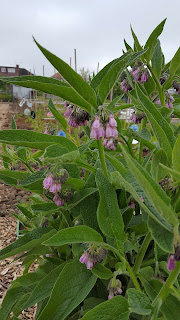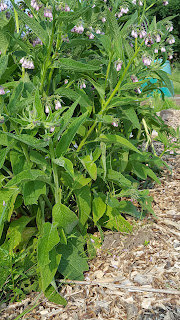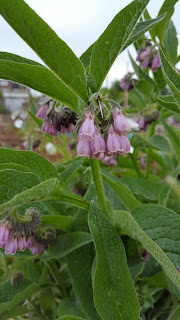Organic Plant Feed
As Spring approaches life in the garden and down on the allotment is stirring and I don’t just mean by the Human form; weeds are slowly coming through as well as perennial herbaceous plants and little creatures.
As the days are warming up; I have noticed my perennial Comfrey plants are showing their young leaves too.
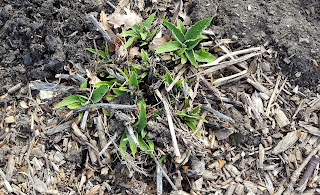 |
| Bocking 14 Comfrey |
Last month I also noticed young Nettle shoots starting to show, growing around the allotment site. The air is definitely warming up, be it slowly, and slugs are coming out from their hibernation too, hungry for young seedlings and new shoots to feast on.
As we prepare to dig our allotment plots and garden borders there is one other task I always start at this time of the year. Making organic feeds using Comfrey and the Common Nettle. Last year, to this collection, I trialled another plant (weed) variety, Common Thistle.
Comfrey:
- Seeds (Symphytum Officinale): when sowed directly in the ground around April time,this wonderful herb can be cut several times in the year. This herb draws nutrients from below the ground. Be warned if this herb variety is not looked after (as its a self seeding variety), can spread to other parts of the garden and if not controlled can become weed like.
- Russian Comfrey: Also known as Bocking 14 Comfrey, has a higher nutrient content (deep rooted) giving more leaves than the wild variety. This variety also produces less seed, so less likely to be invasive. I am very grateful to a social media friend, who sent me a few small roots of this variety, a few years ago, and are now well established plants.
3 ways to use Comfrey
(Comfrey) Tea:
- Pack a container or bucket with as much comfrey leaves as possible.
- place a brick on the leaves to keep them in weighted down (you do not need to do this, but is recommended as it makes the job of straining the liquid easier) and cover with a tight fitting lid or with a piece of plywood with more bricks on top to keep the lid in place. (I use a plastic container with a fitted lid e.g 10ltr paint pots).
- Fill with rain water and place in a warm sheltered environment. (I use tight fitted tubs so place them in the greenhouse but I wouldn’t dare if using buckets)
- THE NEXT STEP COMES WITH A WARNING
- 6 weeks later: When you open the lid of your container make sure you are wearing rubber gloves and BE PREPARED for the putrid smell! A small face mask is recommended ?.
- Strain the liquid either into a watering can and use immediately or store in plastic bottles ( for this stage I use a gorilla bucket to strain liquid into, which makes it easier to then pour it into plastic Jerrycans).
- This homemade feed is now ready to use immediately and does not require watering down as its not in a concentrated form.
Compost Activator:
- Use the leaves and stems of comfrey in layers when making your own compost. I simply take the stems, place them on the footpath and stamp on them, in order to bruise the stalks and leaves, pour a little rain water on them to start the decaying process. Place them in alternative layers of kitchen waste, small twigs and grass clipping and torn up cardboard (e.g egg and cereal boxes).
Trench Filler:
- When planting out (for example, your potato seeds) add a layer of comfrey leaves in the bottom, cover with a thin layer of soil, then place the seed or plant, its a good way to avoid the smell of decaying leaves but also adding the goodness to the crop. I use this method for Tomatoes and all Legumes. As well as trench filler process, a few bottles of homemade comfrey feed are ready for later use during the summer.
Best to use the liquid Comfrey on vegetable plants when flower buds are forming. This will help set the fruit, giving natural organic nutrients back to the plants.
Common Nettle (Stinging Nettle):
“A perennial weed” I hear you say, “just get rid!!” I don’t agree with that. Nettle is rich in Nitrogen. As an organic gardener, I search out all over the common grounds on our allotment site where there are small areas of nettle growing. And like Comfrey; make Nettle brew, an ideal feed especially for leafy plants and heavy feeders. I make and use this homemade nettle feed mainly on my brassica beds.
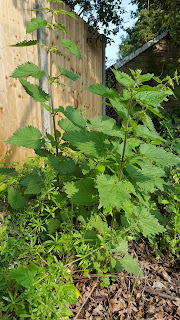 |
| Common Nettle (Stinging) |
To make this brew use both the leaves and stalks (all cut up small). Like Comfrey, fill a tub or bucket and place with a brick topped with water. Unlike Comfrey Tea, ? WARNING a check and stir of the liquid mixture is required, roughly, every 2 weeks until the bubbles that have been created by this process have gone down to a minimal. (Can take up to 7-8 weeks depending on weather conditions).
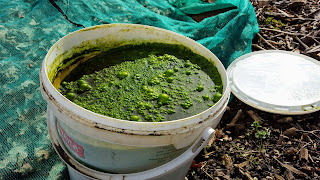 |
| Nettle brew ready for use after 7 weeks. |
This liquid, once strained,and can be used immediately or stored in sealed containers as the aroma is not very pleasant. On the allotment I store it outdoors in a sheltered and shaded area. When feeding the plants dilute on a ration of: 1 part to every 10 parts.
Other Weeds:
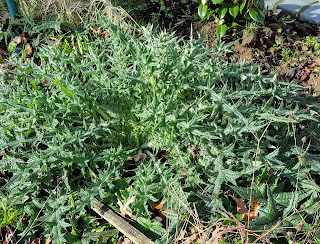 |
| Common Thistle |
Last year I trialled a weed called Common Thistle, it’s another deep rooted weed, and thought same principle could be applied as making Nettle brew. I trialled this brew on 1 section of the brassica bed and crop was just as successful as the one fed with nettle feed.
In our garden this thistle grows right next to my compost bin, taking up the goodness from the composting area. This thistle makes it difficult to mow the grass around the bin. So now rather then fighting the thistle, and trying to dig up its deep roots, will use it and put back to earth its nutrients and the decaying residue into the compost bin.
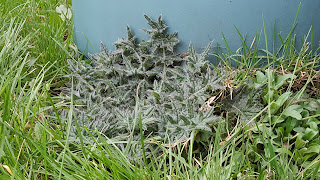 |
| Thistle finds a perfect spot to grow |
Do not put the roots of any weed in your compost bins. Burn them if you can, or put them in the ‘garden waste’ bin. This waste is heated (cooked) to a very high temperature therefore killing the weed roots and all garden waste is recycled and turned back into compost.
Next time you are out in the garden or the allotment, don’t look at these prickly weeds as a Foe but as a friendly ‘feed’.
What do you use to feed your plants? Drop me a comment below or find me on Twitter, Facebook or Instagram; let’s have a chat.
